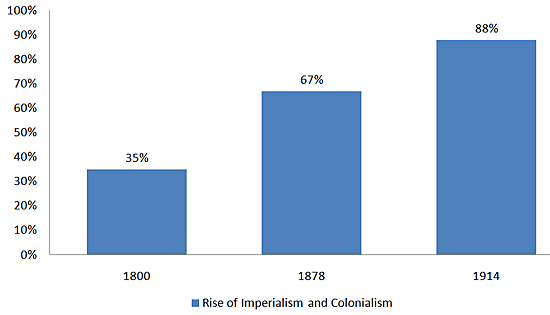
Unit 4: Nationalism, Industrialism, and Imperialism
Lesson B: Resistance to European Rule in India and SE Asia
Opening: European Imperialism
European countries had a long history of colonialism. During the 16th and 17th centuries, they secured colonies in the Americas. In the 18th century, they controlled trading posts along the coasts of Africa and Asia. During the 19th century, imperialism increased quickly. In 1800, thirty-five percent of the world was under the control of European countries. In 1878 the percentage of the world controlled by European countries increased to sixty-seven percent. At the outbreak of World War I in 1914, Europeans controlled eighty-eight percent of the world. It was not until after World War I that imperialism slowly started to end.

Rise of Imperialism and Colonialism
| Year | Percentage of the World Controlled by Europe |
|---|---|
| 1800 | 35% |
| 1878 | 67% |
| 1914 | 88% |
Directions: In order to see the pattern of European imperialism throughout history, view the following images of world maps. After examining the maps as many times as needed, discuss the questions that follow.
Map Showing the Rise of Imperialism and Colonialism Over Time [1]
Classroom Activity - Colonialism
![]() Discussion
Discussion
Directions: Prepare a response to the discussion question(s) below. Follow your teacher's directions to participate in your class discussion.
- What patterns did you see in the maps? Which countries seem to have secured the most colonies throughout history?
- Why do you think these countries sought to secure colonies?
- Which countries appear to have the most colonies in Asia?
- What different opinions would natives have about imperial rule? Why might they have different beliefs?
Select the link to review the Discussion Scoring Tool (pdf).
Page Notes:
[1] Source: This image from http://commons.wikimedia.org/wiki/File:Colonisation2.gif was released into the public domain by its owner and copyright holder, Andrei Nacu.

